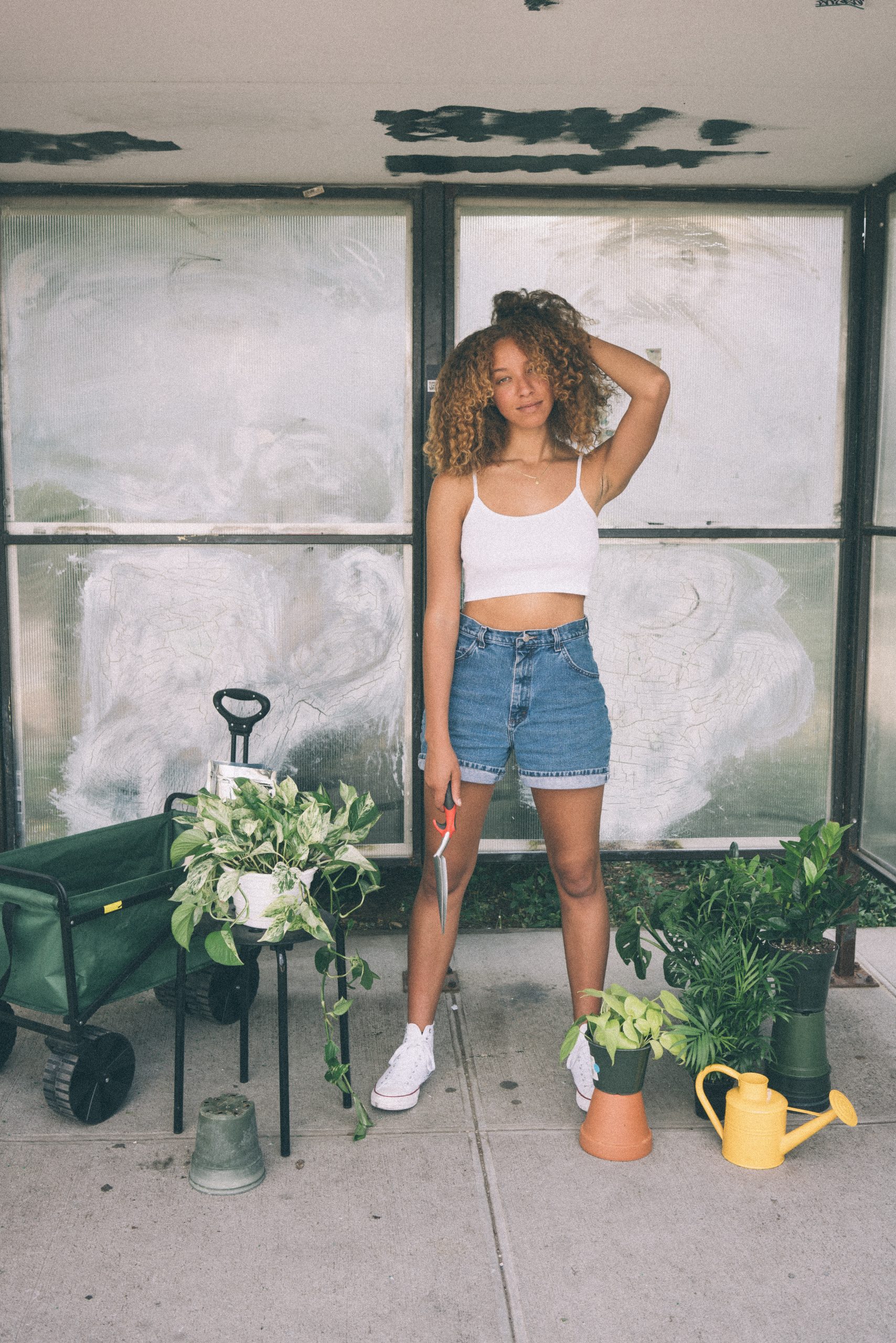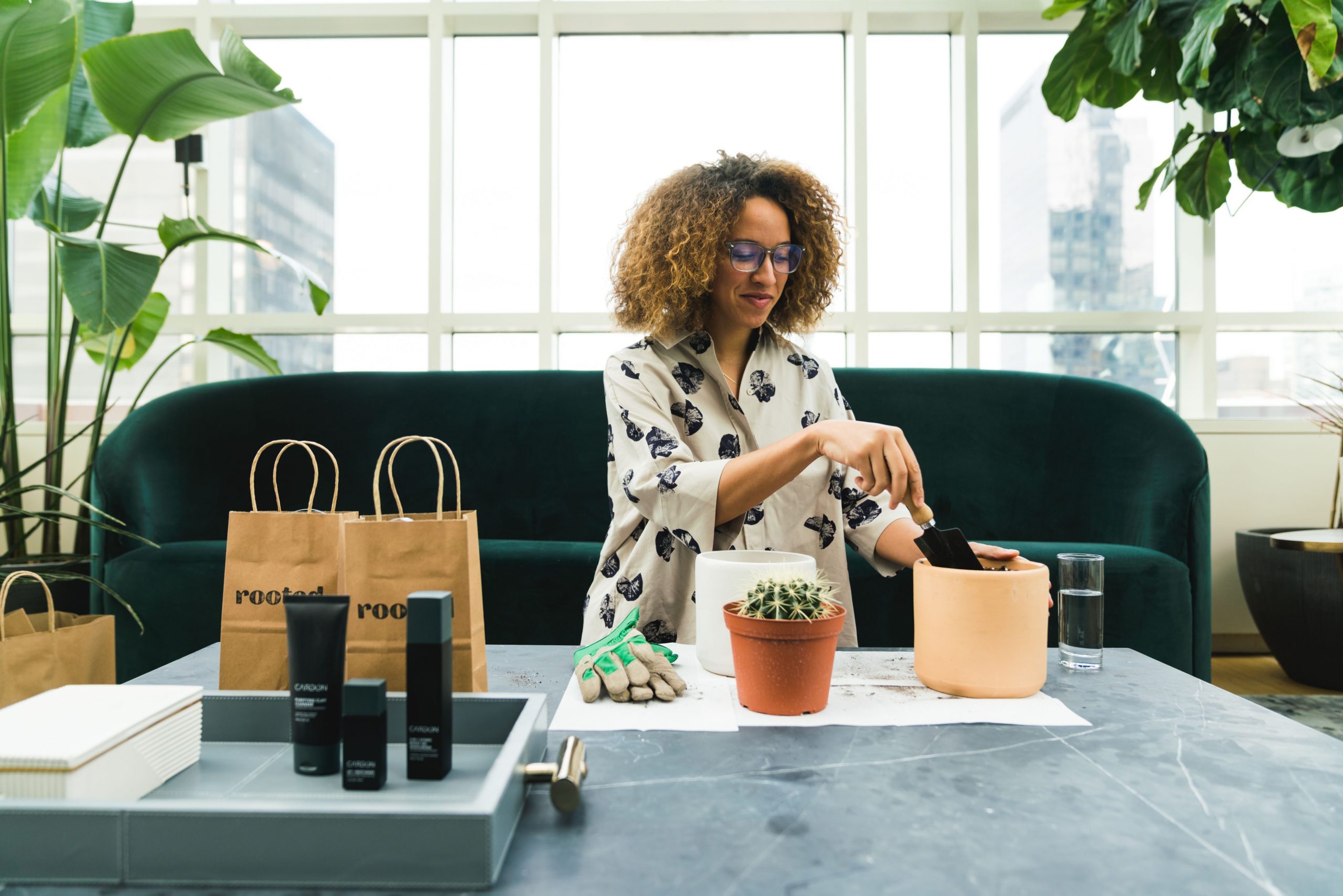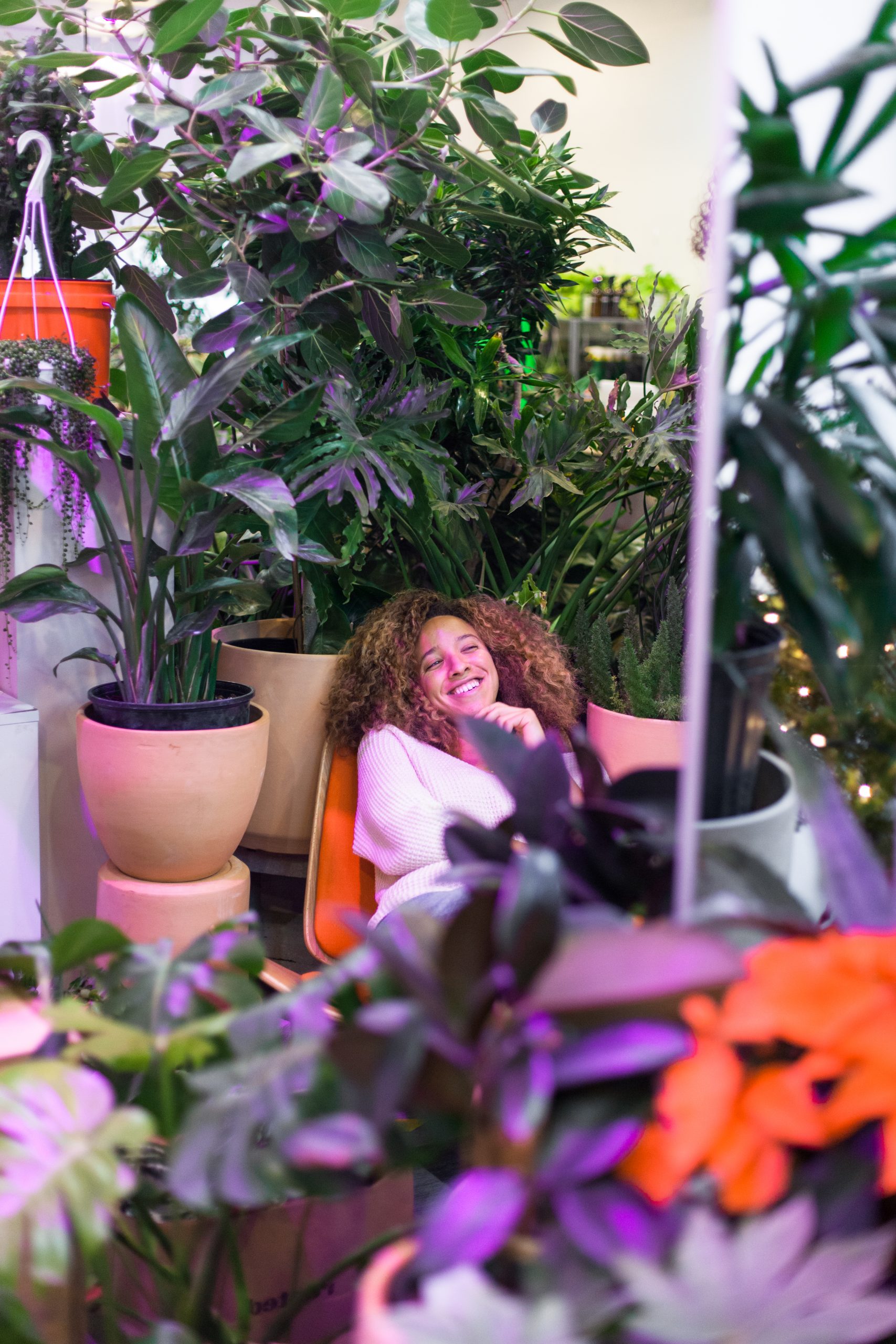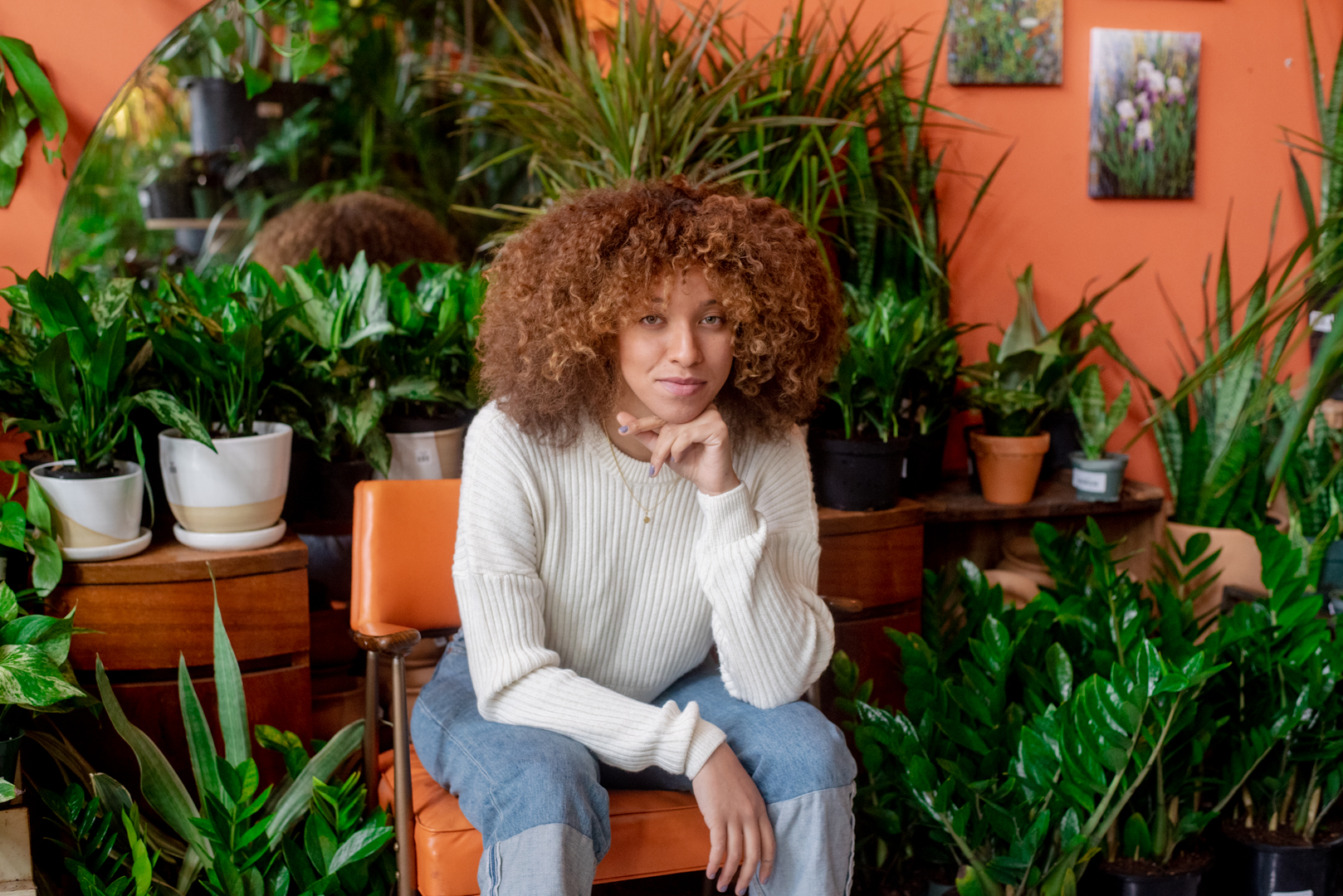
“Plant doctor is a title that I was given at some point along my journey caring for people’s houseplants,” says Maryah Greene of Greene Piece about the one-of-a-kind business she’s lifted off the ground in Brooklyn. “No medicine, just a lot of love and reading on my part.”
Greene’s cheekily-named business—a triple reference to her last name, a nod to the little green lives that fill her space and her time these days, and the environmental agency—deals in bringing sustainable nature to everyone’s indoors. Her philosophy? Everyone should—and can, with a little research, effort, and love—have a green space and not worry about their plants dying.
Through workshops and consultations (which have continued amid the COVID-19 pandemic) she checks in on the needs of the client and space, and then curates it with plants that have the best chance of survival. If your succulents are dying, this metropolitan Mother Nature is probably the person you want whispering advice in your ear. Her work has been recognized by the likes of Vogue, Good Morning America, and The New York Times, and Greene is showing no signs of slowing down.
LADYGUNN spoke to Greene about her day-to-day, the joys of bringing a space to life with plants, and the best green piece to start your journey toward plant parenthood.
So, tell me in your own words what a “plant doctor” is.
I never came up with an officially title for myself but sometimes I go by plant doctor, plant therapist, or plant consultant among other things. My job is to meet people where they are on their houseplant journey and provide them and their plants with any guidance or assistance they might need. The main goal is to get people to feel confident in their plant care practices and provide them with any of the plant care they might not know their plants needed.
Pre-quarantine, put me in your shoes on a typical day on the job.
A typical day on the job starts with a lot of administrative work: sorting through email submissions, scheduling consultations, interviews, planning collaborations, etc. I carve out 30 minutes to an hour each morning to take some time to care for my own plants and check in with them. They often get the last of my energy because my day is so focused on keeping the rest of the world’s plants happy, so I’m trying to be better about that. A wise friend of mine told me to “always remember to water my plants first.”
After the administrative stuff, I make my way to local plant shops or nurseries to start planning or shopping for my next client or project. Depending on what I need, it can take anywhere between an hour to 5 hours to find the right plants, planters, soil etc. If I’m just consulting on any given day, my job entails showing up to someone’s space and letting them give me a tour of their houseplants and hearing the different things they’d tried to keep their plants happy and healthy.
If I have a project on that day, I often find myself hauling an absurd amount of plants and materials into an Uber XL to haul to the project’s location. I meet my client there and get to see the look of joy on their face when I show up with their new plants. That’s one of the best parts of my job.
Sometimes people are looking to add more plants to their space and would like recommendations and others have plants that aren’t doing too well and they’re looking for some help in figuring out why.
What do you enjoy most about working with plants every day? What’s the largest frustration?
I enjoy the “light bulb” moment that my clients get when we’re talking about their plants and we find the reason why it hasn’t been thriving. It could be something as simple as “its time to repot it” or “this plant only likes indirect light and you’ve been giving it direct light”. When we figure out the issue together, I can see the look of relief that people have and it’s super contagious. The largest frustration is losing or having my identity replaced with my job. We live in a society where you’re identity is directly linked to your career and sometimes I feel like people have plant questions that they’re holding in their back pocket waiting to ask me at any given time. Its an honor and privilege to know this much about plants and have people trust my expertise, but I also wish that there was a was a “clock in” and “clock out” card that I could wear on my head to get people to understand that I’m more than my job, regardless of how niche and exciting it is.

Can you talk about a particularly difficult room that you curated?
Just recently I had this massive space in Union Square with very low light. It almost felt like a scam how beautiful this apartment was with the lack of natural sunlight it was receiving. Aesthetically and spatially, I could bring in any plant I wanted, but the limited light, it significantly narrowed down my plant choices. Thus I sourced a grow light to provide the space with a bit more light. I also just made a conscious effort to fill the unconvential spaces that were receiving light with as many plants as I could. The space had random nooks and cutouts next to the windows that were perfect for adding large pots with tall and slim plants, so I spent an entire 48 hours looking for perfectly shaped plants and modern pots. I was so nervous the owner wouldn’t like the outcome and I didn’t sleep all night. In the morning when he returned, his assistant told me he loved it and wanted to add even more.
Is there anyone that you look to for inspiration as far as curating spaces with greenery? I’d imagine you would look to fine artists or interior decorators, but what you do is also so singular that I’m genuinely wondering.
I try to go with my gut. There was a point in time where I was looking any and everywhere for inspiration, but it started suppressing my creativity because there were small things that were out of my control that would prevent me from doing all the things I wanted to do. Sometimes its budget, lighting, someone’s aesthetic or the architecture of the space. I try my best to work on each space individually without comparing it or referencing it to another. It’s safer for me to create on my own and make my own inspiration along the way.
What have you learned about yourself and your relationship to the world when you interacted with plants?
I learned that I am not my productivity. I run a business and I’m an artist. All I know is “work”, “work harder”, and “not good enough”. I often have to remind myself that my plants take time to go dormant during the fall and winter so that they can produce during the spring and summer. Rest is essential; my plants remind me of this everyday. I can’t keep pushing out new leaves 24/7 because it’s not sustainable and it’s not fair to myself.
What’s your favorite plant?
I love this question because it literally depends on my mood that day or hour. Today, it’s a pothos. I’m super grateful for how low-maintenance and flexible pothos plants are. I call them “old faithfuls”.

Best plant for first-time owners or people looking to expand their range as far as plants are concerned?
The monstera plant is perfect for anyone looking to expand their range. Monsteras are a pretty straightforward plant to care for as long as you receive medium to bight indirect light. They need water once every 7-10 days and that’s it. I recommend them to first time owners because of how quickly they produce new leaves and because of the shape of their leaves; no leaf looks exactly the same and they grow with holes in them. Everyone should have a monstera in their life.
Since COVID, a lot of us have been nurturing our green thumbs. In your VOGUE feature, you talked about knowing your plants and being patient. As we continue to plant inside, and with winter on the way, what additional tips can you impart?
Remember that the green thumb isn’t a thing—forget that entire concept. It truly comes down to the right plants for you and your space: your lighting, your daily schedule and your plant’s watering needs are the deciding factors on what makes your plant journey successful. Don’t get down on yourself if one or a few of your plants don’t make it. One of the few factors I mentioned above may have not have even been a great fit for you. As we go into fall and winter, slow up on the fertilizer. Our plants are going to go dormant soon and fertilizing them will disrupt that and potentially fry their roots. Hold off on fertilizer until the spring and let your plants enjoy some rest. Also be conscious of places receiving strong drafts of cold or hot air. Heaters are coming on and cold winds come through windows, both of which can be shocking to your plant. It may be worth moving your plant to another location if that’s the case.

CONNECT WITH GREENE PIECE
story / E.R. Pulgar
